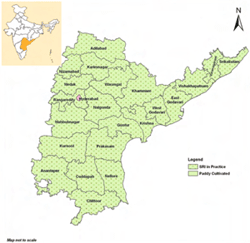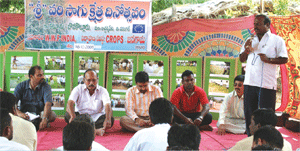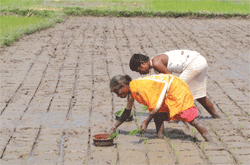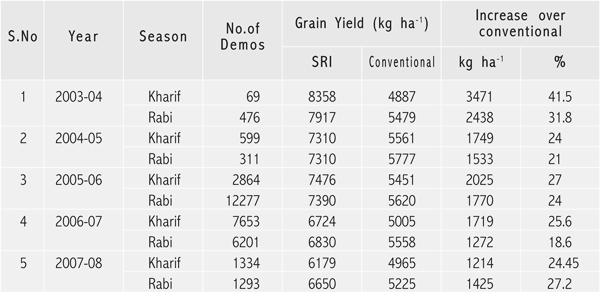|
|
 |
|
| SRI Fact Sheet - Andhra Pradesh |
|
| Total geographical area (km2) |
275 |
| Total population (million) |
76 |
| Total cultivable area (million ha) |
13.4 |
| Total paddy area (million ha) |
3.98
(2006-07) |
| Paddy area (%) to total cultivable area |
3.98 |
| Major rice season(s) |
Kharif, Rabi |
| Total paddy production (million tonnes) |
17.8
(2006-07) |
| State's contribution to national paddy production (%) |
12.6 |
| Paddy productivity (t ha-1) |
4.48
(2006-07) |
| All-India rank in productivity |
4 |
| Constraints in paddy cultivation |
Water scarcity,
drought |
|
 |
|
|
| |
|
 Background Background
Andhra Pradesh ranks fourth in terms of the nation's rice-growing area (3.98 million ha) but second in terms of rice production (17.8 million tonnes) as of 2007. Paddy production during 1997-98 to 2006-07 fluctuated from 12.8 million tonnes to 18.7 million tonnes. Paddy productivity (4.48 t ha-1) is also higher than the national average. Rice is cultivated in all 22 districts of the state and productivity is higher than the national average in 20 districts. The state plays a significant role in rice supply to the national pool and the contribution in 2006-07 was 12.6 percent. The state's area of rice cultivation decreased from 3.6 million ha in 1995-96 to 3.0 million ha in 2004-05, which resulted in decrease in production from 9.216 million tonnes to 8.953 million tones.
 Frequent drought over the past 10 years has left the rice farmers in the doldrums. Andhra Pradesh experienced severe drought in 1999-2000, characterized by water shor tages, falling groundwater levels, and increased risk of contamination of surface water. The drought, followed by low rainfall (534 mm annual rainfall) in the southwest and northeast monsoons during 1999 was exacerbated by groundwater extraction. Agricultural production was seriously reduced in kharif 1999. Thereafter, the thrust for conjunctive water-use became the major concern for scientists and farmers. Depleted water resources, stagnated rice productivity, the growing importance of organic agriculture, increased production costs and the need for better utilization of family labour among small and marginal farmers, calls for a shift in cultivation practice. The System of Rice Intensification (SRI) offers a way to not just reduce the demand for water while growing irrigated rice, but also of simultaneously increasing rice production. SRI was introduced in Andhra Pradesh in kharif 2003 in all 22 districts of the state by Acharya N.G. Ranga Agricultural University (ANGRAU). Since 2003, ANGRAU has taken several initiatives to promote SRI in Andhra Pradesh. Frequent drought over the past 10 years has left the rice farmers in the doldrums. Andhra Pradesh experienced severe drought in 1999-2000, characterized by water shor tages, falling groundwater levels, and increased risk of contamination of surface water. The drought, followed by low rainfall (534 mm annual rainfall) in the southwest and northeast monsoons during 1999 was exacerbated by groundwater extraction. Agricultural production was seriously reduced in kharif 1999. Thereafter, the thrust for conjunctive water-use became the major concern for scientists and farmers. Depleted water resources, stagnated rice productivity, the growing importance of organic agriculture, increased production costs and the need for better utilization of family labour among small and marginal farmers, calls for a shift in cultivation practice. The System of Rice Intensification (SRI) offers a way to not just reduce the demand for water while growing irrigated rice, but also of simultaneously increasing rice production. SRI was introduced in Andhra Pradesh in kharif 2003 in all 22 districts of the state by Acharya N.G. Ranga Agricultural University (ANGRAU). Since 2003, ANGRAU has taken several initiatives to promote SRI in Andhra Pradesh. |
 |
National-level training programme on SRI for Nodal Officers of Department of Agriculture from various states of the country in July 2004.
|
|
|
 |
250 front-line demonstrations of SRI.
|
|
|
 |
Farmer workshops on SRI. |
|
|
 |
Collaborative programmes with ICRISAT-WWF, in promoting SRI and organizing farmers meet. |
|
|
 |
A dialogue on SRI with the Hon’ble Chief Minister, politicians, scientists, farmers and media jointly organized with ICRISAT-WWF in November, 2005. |
|
|
 |
With the support of ICRISAT-WWF, ANGRAU has produced 5,000 SRI manuals, 10,000 booklets (5000 each in English and Telugu), 2,000 copies of farmers experiences, and 100 CDs on SRI cultivation. |
|
|
 |
ANGRAU has also collaborated with print media and television channels in popularizing SRI. |
|
|
 |
ANGRAU organized the first National Symposium on SRI jointly with Directorate of Rice Research (DRRICAR) and WWF on November 17-18, 2006. |
|
|
 |
Conducted state-level three-day workshop on ‘SRI Implements’ (July 17- 19, 2008) involving 50 farmers and entrepreneurs. |
|
|
|
| The state Depar tment of Agriculture has organized SRI demonstrations since 2003-04 and a thrust has been given since Rabi 2005-06, by organizing at least one demonstration in every Gram Panchayat in the state. Under the National Food Security Mission (NFSM), 1680 SRI demonstrations are targeted for 2008-09 (1272 demonstrations for the kharif season and 408 demonstrations for the rabi season) with a financial outlay of Rs.5.0 million @ Rs.3000/- per demonstration and financial assistance of Rs. 3000/- for purchase of conoweeders. Altogether 4,446 one-acre demonstrations will be organized during 2008-09 under Work Plan (Rice) with a total outlay of Rs.26.7 million in the 11 non-NFSM districts of East Godavari, West Godavari, Prakasam, Kurnool, Ananthapur, Kadapa, Chittoor, Warangal, Rangareddy, Nizamabad, and Karimnagar. |
| |
| Performance |
Grain yields obtained in farmers’ fields (2003-04) showed very few cases where SRI yields were lesser than conventional cultivation (Figure).
On-farm demonstrations conducted by ANGRAU, alongside farmers’ practice gave the following positives in terms of plant growth/yields/incomes. |
|
The grain yields recorded in the demonstrations organized by the Department of Agriculture are presented
in the Table 1. |
| |
Experiences in Adoption
From the on-field demonstrations conducted by ANGRAU it could be observed that careful transplanting of the young seedling and wider spacing were adopted in full, instantaneously by all the participants. Planting young seedling, just 8-12 days old, was also adopted by a majority. However, water-management practices were adopted only partly by all respondents, i.e. most of the time but not all the time. Only in 2006 kharif did this
improve tremendously. Nearly 60 per cent participants could practice full adoption, implying that SRI is a |
| |
| Table 1: Productivity recorded under SRI demonstrations from 2003-04 to 2007-08 |
 |
| slow-moving technology worth repeating for years so that beneficiaries continue with the practice gradually after convincing themselves about the real benefit behind the technology. Nearly one-fifth of the participants could not adopt the use of FYM/compost. Cono-weeding missed the full adoption rate. The experience of Department of Agriculture showed that in black soils the performance of both marker and weeder is poor; weeder operation is difficult in general; operational difficulties occur when it comes to adoption over larger areas; there is difficulty in preparation of nursery bed and transplantation. |
| |
Way Forward
SRI methodologies offer attractive opportunities for farmers in Andhra Pradesh to save water while increasing their rice output. It is obvious from farmer experiences that SRI has the advantage of cost effectiveness and increased yield per unit area when compared to conventional paddy cultivation. However, there are some areas, for example motorizing the conoweeder, training farm labour, developing location-specific SRI packages and institutional linkages which need to be addressed for up-scaling SRI in the state. It is for the policy makers to realize that more impetus needs to be given for large-scale adoption of SRI in the state. |
|
|
| |
|